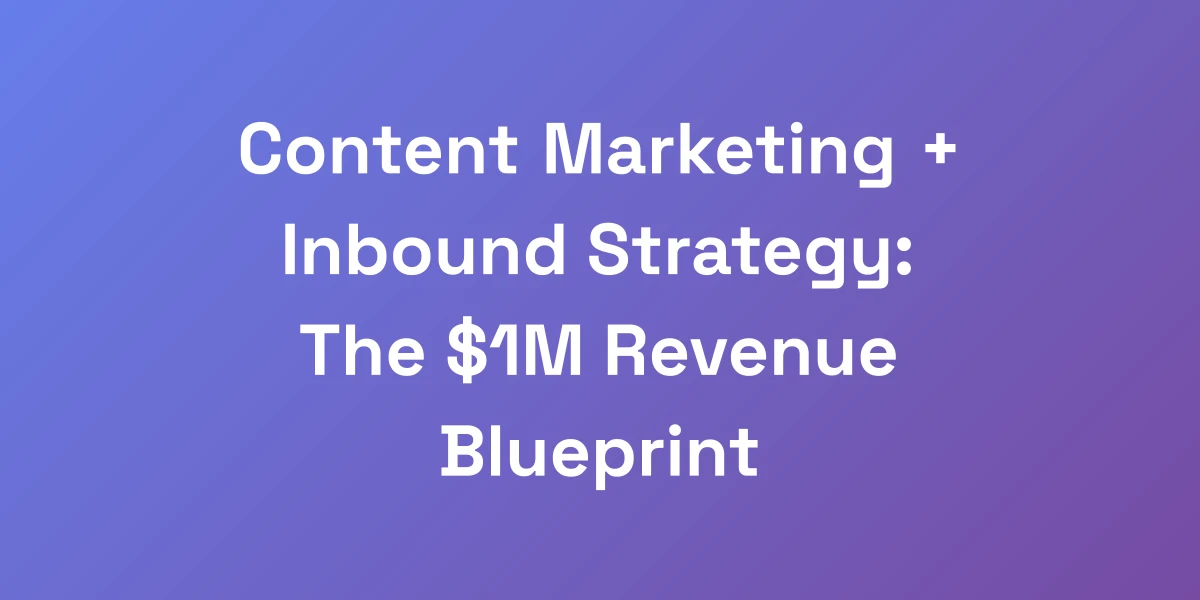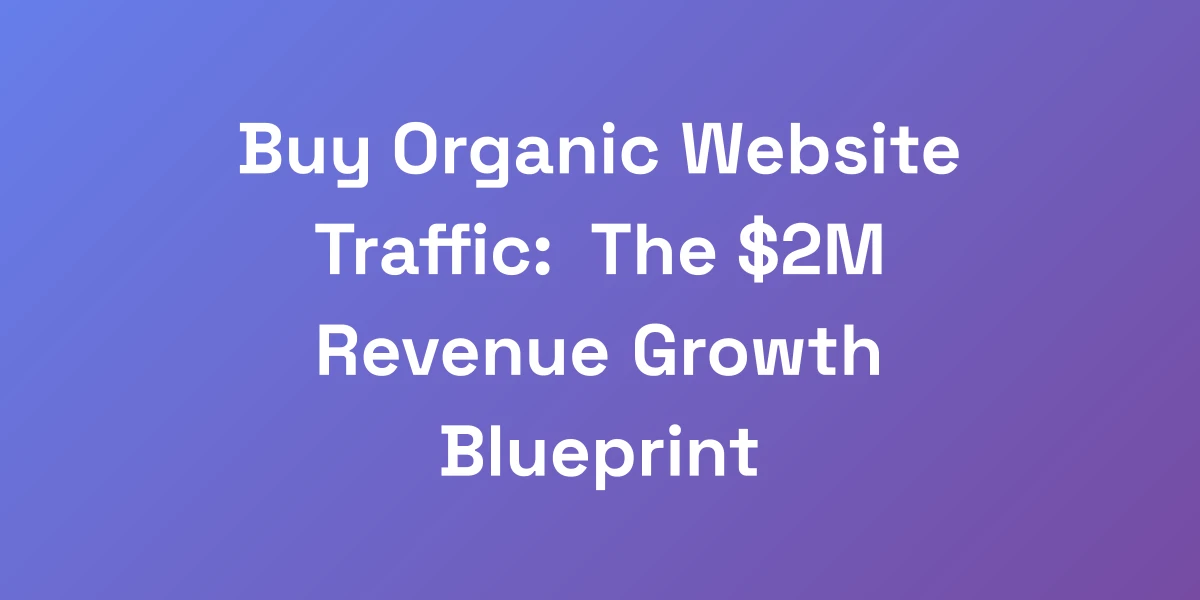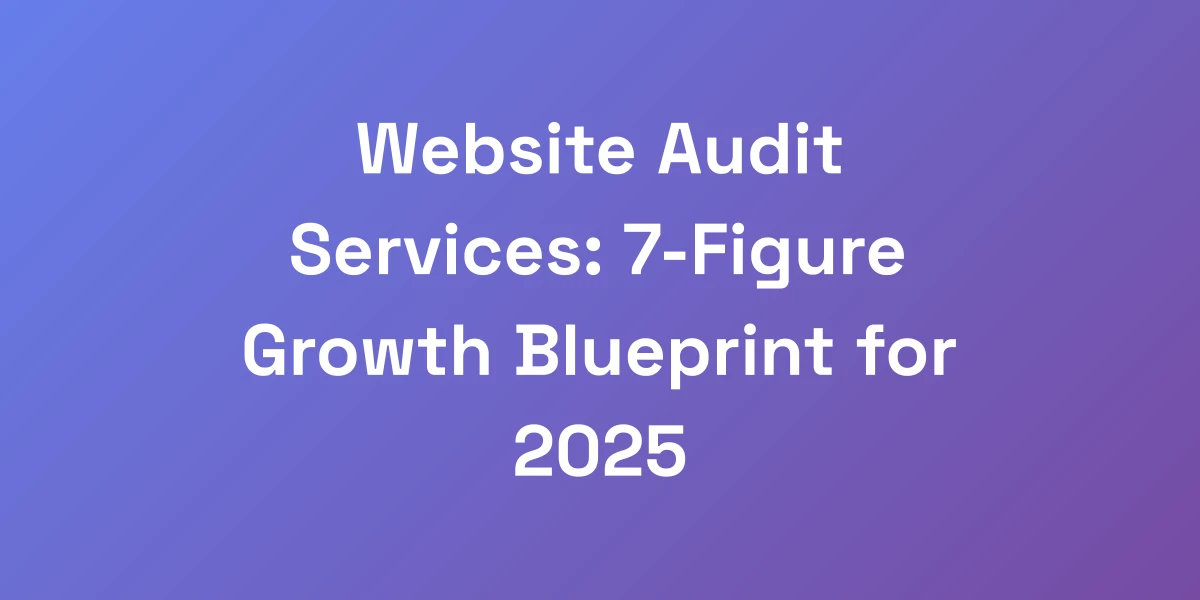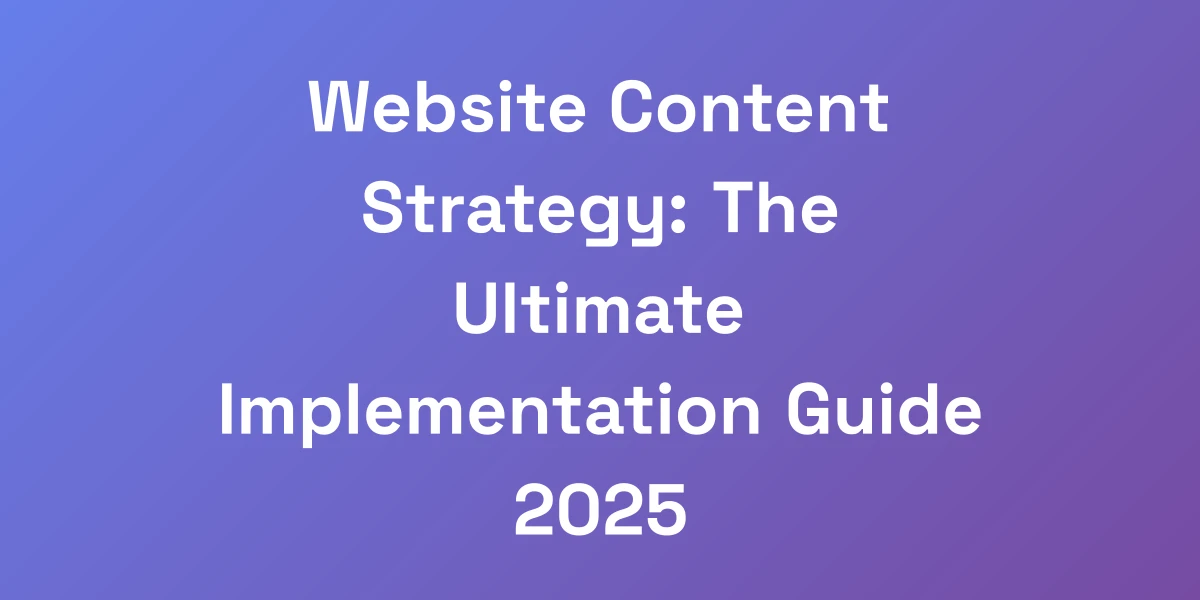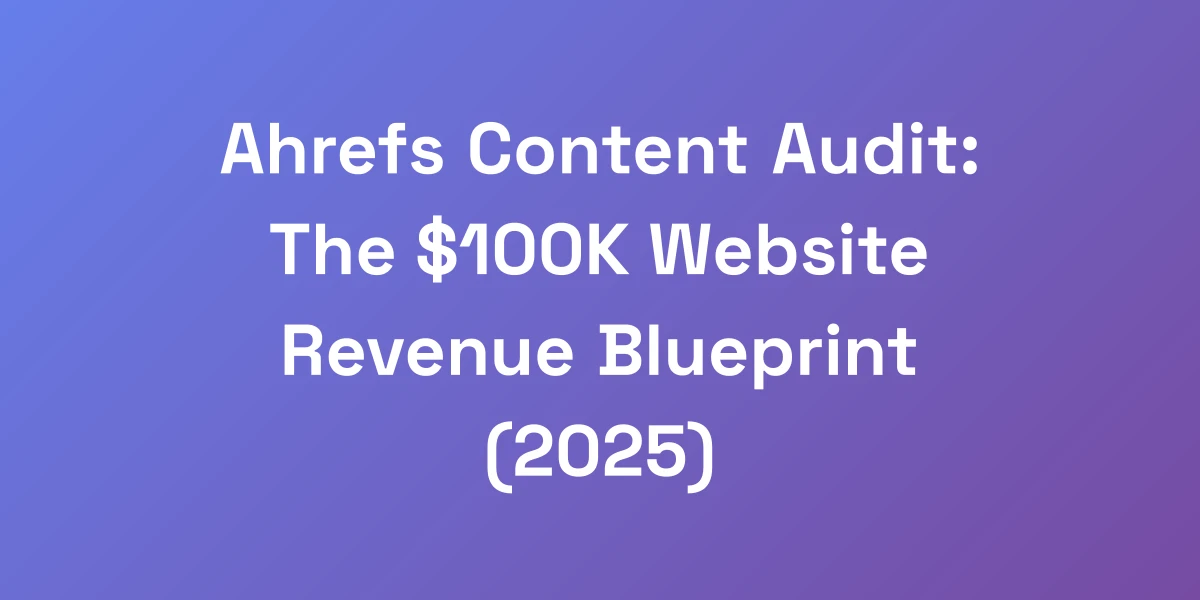
Ahrefs Content Audit: The $100K Website Revenue Blueprint (2025)
Apr 8, 2025 | By [email protected]
Why 90% of Content Audits Fail (And How to Fix It)
Let me hit you with some truth: Most content audits are a complete waste of time. Why? Because people are obsessed with vanity metrics that don’t move the needle.
We’ve seen content audits that have generated millions in revenue, and I can tell you that the difference between a game-changing audit and a useless spreadsheet exercise comes down to one thing: knowing exactly what drives revenue.
In this guide, we’re going to show you how to use Ahrefs to conduct a content audit that actually impacts your bottom line, not just your ego.
The Real Cost of Poor Content Performance
Think about it: Every underperforming piece of content is like leaving money on the table. Poor content doesn’t just fail to attract visitors; it can actively harm your site’s reputation and SEO ranking.
For instance, a blog post that’s outdated or irrelevant can drive potential customers away, reducing trust and engagement. This loss isn’t just in traffic—it’s lost revenue.
- Decreased Organic Traffic: Low-quality content won’t rank well, leading to fewer visitors.
- Lower Engagement Rates: Visitors are less likely to interact with content that doesn’t meet their needs.
- Wasted Resources: Time and effort spent creating content that doesn’t perform could be better invested elsewhere.
Why Traditional Content Audits Don’t Work
Traditional content audits focus too much on surface-level metrics like page views and bounce rates. Sure, these are important, but they don’t tell the whole story.
Without linking these metrics to revenue, you’re missing the bigger picture. An audit without a revenue-first approach is like trying to win a race blindfolded.
- Vanity Metrics: Focusing on likes and shares without understanding their impact on sales.
- Lack of Strategic Focus: Missing out on content that can actually drive conversions.
- Insufficient Data Integration: Not leveraging all available data to make informed decisions.
The Revenue-First Audit Framework
Our framework is simple: prioritize content based on its revenue potential, not just its traffic. This means identifying which pieces can be optimized to drive more sales and aligning them with your business goals.
Here’s how we do it:
- Identify High-Value Content: Focus on content that already has some traction but isn’t fully optimized.
- Analyze Revenue Impact: Determine how each piece contributes to your overall revenue.
- Optimize for Conversions: Make strategic updates that enhance the content’s ability to convert.
Setting Up Your Ahrefs Dashboard for Maximum Impact
To get started, you need to set up your Ahrefs dashboard in a way that highlights the metrics that matter most to your revenue goals.
Here’s a step-by-step guide:
- Custom Reports: Create custom reports that focus on revenue-generating metrics.
- Advanced Filters: Use Ahrefs’ advanced filters to sift through your content and identify key opportunities.
- Real-Time Tracking: Set up real-time monitoring to track the performance of your high-value content.
Quick Wins vs. Long-Term Growth Strategies
Not all optimizations are created equal. Some can provide quick wins—a boost in traffic or minor revenue increases—while others require a long-term strategy for sustainable growth.
Here’s how to balance the two:
- Quick Wins:
- Update outdated stats and information.
- Add internal links to existing high-converting pages.
- Improve meta descriptions and titles for better click-through rates.
- Long-Term Strategies:
- Develop comprehensive pillar content that covers topics in depth.
- Implement a content refresh cycle to keep all content up-to-date.
- Build a robust backlink profile to enhance domain authority.
The 7-Step Ahrefs Content Audit System
Listen up, because this is where we separate the pros from the amateurs. We’ve refined this process across hundreds of websites, and it’s designed to identify money-making opportunities in under 60 minutes.
We’re not just looking at traffic—we’re hunting for content that can be transformed into revenue-generating assets. Using Ahrefs’ Site Audit and Content Explorer, we’ll create a systematic approach that scales.
This isn’t about creating more content—it’s about making your existing content work harder.
Initial Data Collection and Setup
Start your audit by collecting all necessary data. This includes your site’s entire content inventory, performance metrics, and current SEO status.
- Export Content: Use Ahrefs to export all URLs, titles, and performance data.
- Set Baselines: Establish baseline metrics such as current organic traffic, conversion rates, and revenue per page.
Content Performance Metrics That Actually Matter
Forget metrics that look good but don’t drive revenue. Focus on what truly matters:
- Revenue Contribution: How much revenue each page is generating.
- Conversion Rates: Percentage of visitors converting from each piece of content.
- Engagement Metrics: Time on page, bounce rate, and user interactions and social media benchmarks.
Competitor Gap Analysis Using Ahrefs
Understanding where your competitors are excelling can reveal opportunities for your own content.
- Identify Competitors: Use Ahrefs to find who’s ranking for your target keywords.
- Analyze Their Content: Look at their top-performing pages and understand why they’re successful.
- Find Gaps: Identify topics or keywords your competitors are covering that you’re not, potentially leveraging strategies from SEO for startups.
Content Quality Scoring System
Implement a scoring system to objectively evaluate content quality. This helps prioritize which pieces need attention first.
- Accuracy: Is the content factually correct and up-to-date?
- Depth: Does it cover the topic comprehensively?
- Readability: Is the content easy to read and understand?
Priority Matrix for Content Updates
Not all content updates are equally important. Use a priority matrix to decide where to focus your efforts.
- High Revenue, Low Traffic: Optimize to boost traffic and revenue.
- High Revenue, High Traffic: Refine to maximize conversions.
- Low Revenue, High Traffic: Reallocate resources towards content that can drive more revenue.
- Low Revenue, Low Traffic: Decide whether to revamp or retire the content.
ROI Calculation for Each Content Piece
Determine the return on investment for each content update. This ensures that your efforts are financially justified.
- Calculate Revenue Potential: Estimate the additional revenue each content piece could generate.
- Assess Costs: Consider the time and resources required for each update.
- Prioritize Based on ROI: Focus on updates that offer the highest return on investment.
Action Plan Development
Create a detailed action plan based on your audit findings. This should include specific tasks, deadlines, and responsible team members.
- Task Assignment: Assign tasks based on your team’s strengths.
- Set Deadlines: Ensure timely execution of your content updates.
- Update Plan: Create a detailed plan for each piece of content that needs updating, similar to the approaches in digital marketing for small businesses.
- Track Progress: Regularly monitor the status of your action plan to ensure it stays on track.
Advanced Ahrefs Features Most People Miss
Here’s where we dive into the features that 99% of Ahrefs users never touch. I’m talking about the hidden goldmines within the platform that can multiply your content’s impact.
These aren’t just random tools—they’re strategic weapons for identifying untapped opportunities and fixing critical issues that are bleeding your site’s potential.
We’ve used these exact features to help clients 10x their organic traffic in less than 12 months.
Content Explorer’s Advanced Filters
Content Explorer is a powerhouse tool for discovering high-performing content.
- Filter by Date: Find recently updated content that’s gaining traction.
- Engagement Metrics: Use advanced filters to sort by shares, backlinks, and traffic.
- Topic Relevance: Ensure the content aligns with your niche and audience interests.
Site Structure Analysis Tools
A well-organized site structure is crucial for both SEO and user experience.
- Crawl Overview: Analyze how well your site is crawled by search engines.
- Orphan Pages Detection: Identify and fix pages that aren’t linked internally.
- Internal Linking Opportunities: Strengthen your site structure by enhancing internal links.
Custom Reports and Dashboards
Customize your reports and dashboards to focus on the metrics that matter most to your revenue goals.
- Revenue-Focused Metrics: Track the specific data points that drive your revenue.
- Visualization Tools: Use charts and graphs to better understand your data at a glance.
- Automated Reports: Schedule regular reports to stay updated on your content’s performance.
Automated Audit Workflows
Save time and ensure consistency by automating parts of your audit workflow through marketing automation for agencies.
- Scheduled Audits: Set up regular audits to keep your content fresh and optimized.
- Automated Alerts: Get notified when critical issues are detected.
- Integration with Other Tools: Seamlessly integrate Ahrefs with your other SEO and content tools.
Content Gap Opportunities
Content gaps represent areas where your competitors are ranking but you aren’t.
- Identify Missing Topics: Use Ahrefs to discover topics your competitors are covering that you missed.
- Keyword Opportunities: Find keywords that can drive new traffic and conversions.
- Content Expansion: Expand your content to cover these gaps comprehensively.
Historical Performance Tracking
Understanding how your content has performed over time can provide valuable insights.
- Trend Analysis: Identify trends in your content performance to inform future strategies.
- Performance Benchmarks: Compare current performance against historical data.
- Long-Term Improvements: Track the impact of your optimizations over time.
Turning Audit Insights into Revenue
Stop treating your content audit like a checklist exercise. It’s time to turn these insights into cold, hard cash.
We’re going to show you how to prioritize your content updates based on revenue potential, not just traffic metrics. We’ll create a system that identifies your highest-impact opportunities and helps you execute changes that drive immediate results.
This is the exact process we’ve used to help businesses generate six-figure returns from their existing content.
Creating Action-Priority Matrices
Develop matrices that rank content based on their potential impact on revenue.
- Impact vs. Effort: Prioritize content that offers high impact with minimal effort.
- Revenue Potential: Focus on content that can drive the most revenue.
- Strategic Alignment: Ensure content aligns with your long-term business goals, similar to strategies used in digital marketing for agencies.
Content Optimization Workflow
Establish a streamlined workflow for updating and optimizing your content.
- Audit Findings: Document all insights from your content audit.
- Update Plan: Create a detailed plan for each piece of content that needs updating, similar to the approaches in digital marketing for small businesses.
- Execution: Assign tasks to team members and ensure timely completion.
Measuring Revenue Impact
Track the financial impact of your content optimizations to ensure they are delivering as expected.
- Revenue Attribution: Use attribution models to link content updates to revenue changes.
- Performance Metrics: Monitor key metrics such as conversion rates and sales.
- Continuous Improvement: Use the data to refine and improve your content strategies continuously.
Scaling Success Patterns
Identify what works and scale those strategies across your entire content portfolio.
- Replication: Apply successful tactics to other content pieces.
- Standardization: Create standard processes for content optimization.
- Automation: Leverage Ahrefs’ automated workflows to handle repetitive tasks efficiently.
Team Implementation Guide
Ensure your team is aligned and equipped to execute the content optimization plan effectively.
- Role Assignment: Define clear roles and responsibilities for each team member.
- Training: Provide necessary training on using Ahrefs and understanding the audit process.
- Communication: Maintain open lines of communication to handle any issues quickly.
Monthly Monitoring System
Set up a system to regularly monitor your content’s performance and make adjustments as needed.
- Regular Reviews: Schedule monthly reviews to assess progress and performance.
- Adjust Strategies: Be ready to tweak your strategies based on what the data shows.
- Report Enhancements: Continuously improve your reporting to capture the most relevant data.
Case Study: From 50K to 500K Monthly Visitors
Theory is worthless without proof. In this section, we’ll walk you through a real-world case study where we used this exact Ahrefs content audit system to 10x organic traffic and generate over $300,000 in additional revenue.
You’ll see the exact steps, decisions, and pivots we made along the way. More importantly, you’ll learn how to avoid the costly mistakes that most people make when implementing their audit findings.
Initial Site Analysis
We started by conducting a thorough site analysis using Ahrefs’ Site Audit tool. This helped us identify technical issues and gather comprehensive data on content performance.
- Technical Health: Fixed crawl errors, improved site speed, and enhanced mobile usability.
- Content Inventory: Compiled a complete list of all existing content to evaluate.
- Performance Metrics: Analyzed traffic, engagement, and conversion data for each piece of content.
Content Categorization
Next, we categorized the content based on its performance and revenue potential.
- High Performing Content: Content already generating significant traffic and revenue.
- Underperforming Content: Pages with potential that need optimization to boost performance.
- Low Potential Content: Content that may need to be retired or completely revamped.
Implementation Timeline
Creating a timeline was crucial to keep the project on track.
- Phase 1: Immediate fixes for critical issues.
- Phase 2: Optimization of high and underperforming content.
- Phase 3: Ongoing monitoring and adjustments based on performance data.
Key Optimization Moves
We implemented several key optimizations to turn underperforming content into revenue-generating assets.
- Content Refresh: Updated information, added new data, and improved readability.
- SEO Enhancements: Optimized keywords, meta descriptions, and internal linking.
- Conversion Optimization: Added clear calls-to-action and improved user experience.
Revenue Attribution
After implementing the optimizations, we tracked the revenue generated by each content piece.
- Attribution Models: Applied multi-touch attribution to accurately link content updates to revenue increases.
- Data Analysis: Used Ahrefs and Google Analytics to monitor changes in traffic and conversions.
- ROI Measurement: Calculated the ROI for each content piece to ensure the effectiveness of our strategies.
Lessons Learned
This case study taught us several critical lessons about the power of a revenue-first content audit:
- Focus on Revenue, Not Just Traffic: Prioritizing revenue over vanity metrics leads to more impactful optimizations.
- Comprehensive Approach: Combining technical fixes with content improvements yields the best results.
- Continuous Monitoring: Regularly tracking performance ensures ongoing success and allows for quick adjustments.
Conclusion
We’ve taken you through the ins and outs of conducting a highly effective Ahrefs content audit, designed not just to improve your SEO but to significantly boost your revenue.
The key takeaway? A successful content audit requires a revenue-first mindset, using the right tools, and implementing strategic optimizations that drive real financial results.
Ready to transform your website into a $100K revenue machine? Start your Ahrefs content audit today and watch your revenue soar.
What challenges have you faced with content audits? Share your experiences in the comments below—we’re all in this together, and your insights could help others achieve similar success.
